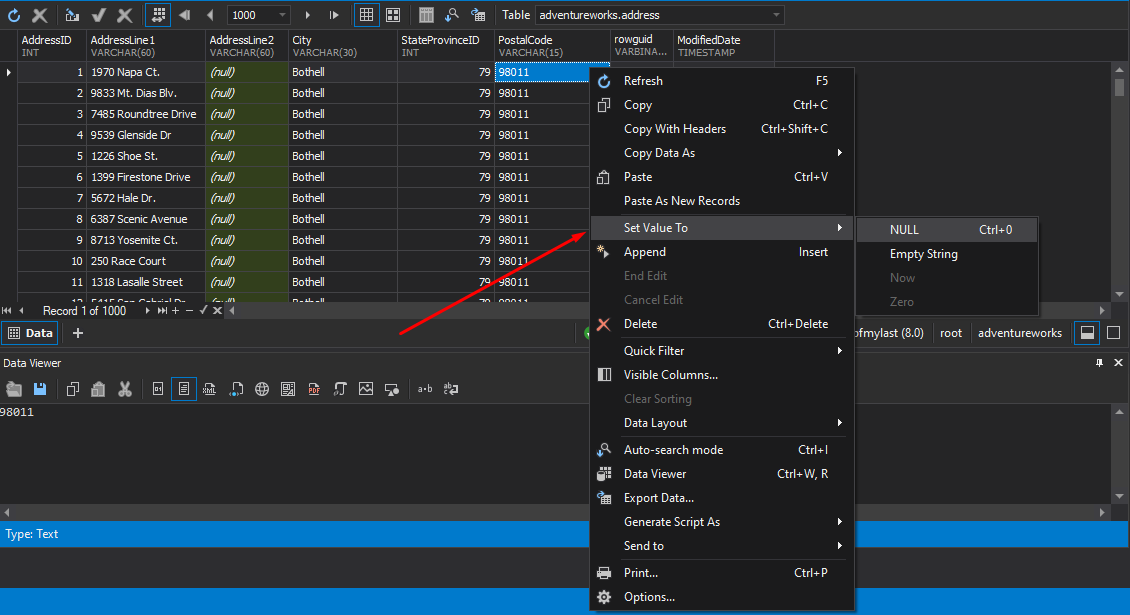Editing Data in Grid Overview
When dbForge Query Builder for MySQL executes any statement returning a result set, the retrieved data is displayed in Data Editor of the data view of the same SQL document. This topic shows how to edit the data in grid. For information about customizing data grid, sorting, grouping, and filtering, see Viewing Data in Grid Overview.
To edit data:
-
In Data Editor, available in the Data view of the SQL document, click a cell you want to edit.
-
To confirm the changes, click End Edit under the grid or select the End Edit option on the shortcut menu.
Tip: To discard changes, click Cancel Edit or select the Cancel Edit option on the shortcut menu.
In dbForge Query Builder for MySQL, you can also edit data right after retrieving it from a table or in the data view after any query was executed.
To retrieve data, in Database Explorer, right-click the table you need and select Retrieve Data from the shortcut menu. To make received data editable, choose the table name from the Table drop-down list on the toolbar or leave it read-only by selecting (read-only).

If you choose the read-only mode, you will gain in the performance aspect, as the application will work faster in this mode.
To edit data in join query results, set the table you want to edit data from to the editable mode, as described above. After you set one table as editable, the data of other tables included into the result will become light-gray.
Note
When you change the mode of any table from read-only to editable or vice versa, a balloon with the corresponding message is shown on the status bar.
Note
To view values of CHAR and VARCHAR fields, consider the following points:
- If length >= 200 is stated in the column type, buttons will be shown in the grid. Click these buttons, and the editor will be shown in a separate window.
- If there are more than 4000 symbols in a cell, data can not be edited directly in the cell. To edit data in such cells, click […].
To insert, delete, copy, and paste data:
Use the shortcut menu or the corresponding buttons under the grid. For example, you can do the following:
-
To insert NULL (instead of empty string), double-click the cell and select Set Value To -> Null on the shortcut menu or press CTRL+0.
Tip: Use Set Value To menu to set an empty string, zero, or current date.

-
To add a new record, select the Append option from the shortcut menu or click
 Append under the grid. To delete a record from the grid, select the Delete option from the shortcut menu or click
Append under the grid. To delete a record from the grid, select the Delete option from the shortcut menu or click  Delete under the grid or press CTRL+DEL.
Delete under the grid or press CTRL+DEL. -
To copy and paste cell values, use the corresponding options on the shortcut menu.
To select data:
You can select and copy data just like cells in a spreadsheet. Do either of these actions:
-
Move the mouse pointer across the grid holding the left mouse button.
-
Click the first cell of the data range, press SHIFT, and, holding the SHIFT key, click the last cell. A rectangular range of cells will be selected.
Tip: Using CTRL, include and exclude cells to selection. Any number of rows may be copied and pasted to another application, for example, a spreadsheet, but when you paste data in the data grid, only the first row will be pasted.
Note
Some queries return read-only data, for example, queries with aggregate functions (count, avg etc.), or data, retrieved from non-updatable views. Such data can’t be edited. It is also impossible to edit the result of executing the script with several SELECT statements.
Row and cell indicators
When working with the grid, you can see special indicators near to the focused cell. These indicators reflect the current editing state.
When working with grid, you can see special indicators near to the focused cell. These indicators reflect the current editing state.
 The row is focused.
The row is focused.
 The row is being edited.
The row is being edited.
 The row has been edited.
The row has been edited.
 Incorrect value was entered into a cell. You must either fix the value or press ESCAPE to cancel the changes made to the cell.
Incorrect value was entered into a cell. You must either fix the value or press ESCAPE to cancel the changes made to the cell.